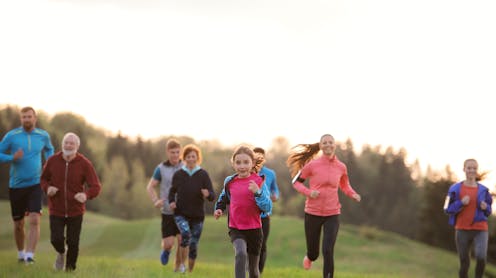The new national plan for sport has no measurable targets
- Written by Anthony Veal, Adjunct Professor, Business School, University of Technology Sydney

The federal minister for sport, Anika Wells, recently launched a discussion paper[1] for a new National Plan for Sport, which will be the fourth such plan produced since 2001.
These plans typically have two main goals: to promote success in elite sport, particularly internationally, and to increase grassroots participation in sport by Australian children and adults.
They’re important policy documents because, ideally, they should play a major role in deciding federal sports funding across the country.
But historically, the plans have failed to get more adults into community sport. So how does this one stack up? And will it be any different?
Read more: Which sports are best for health and long life?[2]
A history of plans with mixed results
Since 2001, governments of the day have released four national plans. All of them have tried to get more people aged 15 and over into sport, but they’ve expressed that aim differently:
In the 2001 plan[3] under the Coalition government, the second goal was to “significantly increase the number of people participating in sport right across Australia”.
A decade later, the Labor government adopted a new plan[4]. Its first objective was to “increase participation in sport and active recreation”.
The Coalition government released the Sport 2030[5] plan in 2018, wanting “more Australians, more active, more often”. This time there was a target: increase participation by 15% by 2030.
Which brings us to the most recent discussion paper[6] from the current government. It aims to “maximise access and rates of participation and other involvement in sport and physical activity”.
The Australian Sports Commission, the government’s main sports promotion agency, has also published Australia’s Sports Participation Strategy[7], which speaks of fostering “greater engagement and participation in sport across the nation”.
Read more: What makes kids want to drop out of sport, and how should parents respond?[8]
Stagnant sporting numbers
While all sound noble in their goals, the plans so far have failed to increase participation.
This is demonstrated in the diagram, which uses data from the Australian Sports Commission’s annual surveys[9] of up to 20,000 adults.
It indicates the proportion of the adult population engaging in sport and physical activity with varying frequency (from three or more times a week to none at all) over the periods 2003–10 and 2016–23 (there were no comparable surveys in 2011-15).
The results for the two periods cannot be directly compared due to differing survey methodologies. However, the trends within each period were similar: no increase in participation.
The question arises: will the outcomes of the new plan be any different? The answer: probably not.
Policy documents lacking in data
There are many reasons why it’s likely this plan won’t fare much better than previous attempts.
First, planning documents produced by ministers and the sports commission typically fail to admit to the central problem: 20 years (and more) of policy effort have failed to move the dial on grassroots sport participation in Australia.
The data showing this does not appear anywhere in the current published planning documents. In fact, despite the commitment to increasing sport participation, neither of the two documents presents any data on current or past adult sport participation rates.
Second, it is not clear what exactly the plan will set out to do. For example, in the diagram, there is a persistent 10–15% of the population who engage in no sport or physical recreation activity at all. Is the aim to reduce the size of this group? The documents don’t say.
Read more: Many Australian kids abused in sport won't ever speak up. It's time we break the silence[10]
On the other hand, the group that participates less than once a week could be targeted to increase the frequency of participation, thus gaining more health benefits.
The emphasis in the documents, however, is on inclusivity, which implies the problem lies with groups being excluded on grounds of such characteristics as ethnicity, disability or gender.
This focus is of course commendable on grounds of equity. However, this policy stance has been in place in sport plans since 2001 but, according to the sports commission’s own survey evidence, overall participation hasn’t budged.
In the case of disability and ethnicity, the various groups’ participation rates have barely changed.
Gender is an exception, with five of the seven surveys since 2016 seeing higher female participation rates than men. However, neither the continuing problems with disability and ethnicity nor the apparent success story in regard to gender is discussed in the current planning documents.
Finally, it is possible governments don’t take sport policy seriously, despite the hundreds of millions of dollars spent on the sector by the federal government each year. After all, it’s millions, not billions.
With policies expressed only in general terms and no attempt to measure specific policy outcomes, there is no obligation to assess the collective effects of grants programs on sport participation.
The more cynical among us may think, then, that grants can be allocated to maximise political, rather than sporting benefits. Such allegations have been levelled before, particularly during the sports rorts[12] saga.
As long as the policies remain imprecise and unmeasurable, only the government and the sports commission get to decide whether they’re working. They might well have a different definition of success to the rest of us.
References
- ^ discussion paper (consultations.health.gov.au)
- ^ Which sports are best for health and long life? (theconversation.com)
- ^ 2001 plan (parlinfo.aph.gov.au)
- ^ a new plan (parksleisure.com.au)
- ^ Sport 2030 (www.sportaus.gov.au)
- ^ discussion paper (consultations.health.gov.au)
- ^ Australia’s Sports Participation Strategy (www.ausport.gov.au)
- ^ What makes kids want to drop out of sport, and how should parents respond? (theconversation.com)
- ^ annual surveys (www.clearinghouseforsport.gov.au)
- ^ Many Australian kids abused in sport won't ever speak up. It's time we break the silence (theconversation.com)
- ^ Shutterstock (www.shutterstock.com)
- ^ sports rorts (www.theguardian.com)














